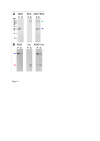Use of human amelogenin in molecular encapsulation for the design of pH responsive microparticles
- PMID: 22630169
- PMCID: PMC3403901
- DOI: 10.1186/1472-6750-12-25
Use of human amelogenin in molecular encapsulation for the design of pH responsive microparticles
Abstract
Background: Proteins can be used in drug delivery systems to improve pharmacological properties of an active substance. Differences in pH between tissues can be utilized in order to achieve a targeted drug release at a specific location or tissue, such as a tumor. The enamel matrix protein amelogenin has a pH dependent solubility profile and self-assemble to form aggregates at neutral pH. This could make amelogenin useful in the design of pH responsive drug delivery systems.
Results: In this study amelogenin was evaluated as a pH responsive component in drug delivery applications. This was achieved by testing the ability of amelogenin to entrap/release other proteins upon changes in pH, and by testing if amelogenin could confer pH responsiveness to an existing and versatile drug delivery system, such as gelatin microparticles. Amelogenin was able to encapsulate bovine serum albumin and insulin, whichwere used as model target proteins. The composite aggregates of amelogenin and target protein were formed at neutral pH and could be reversibly solubilized at weakly acidic pH. Gelatin microparticles prepared in the presence of amelogenin, showed a modulated structure in response to pH change, when studied by scanning electron microscopy, compared to particles without amelogenin. At neutral pH amelogenin induced formation of pores in the particle surface, which were not present at acidic pH, or in particles lacking amelogenin.
Conclusions: The results from this study demonstrate that amelogenin can be a useful component in drug delivery systems in order to achieve a pH dependent response.
Figures





Similar articles
-
Random mutagenesis of amelogenin for engineering protein nanoparticles.Biotechnol Bioeng. 2015 Jul;112(7):1319-26. doi: 10.1002/bit.25556. Epub 2015 Feb 20. Biotechnol Bioeng. 2015. PMID: 25664685
-
Dynamic interactions of amelogenin with hydroxyapatite surfaces are dependent on protein phosphorylation and solution pH.Colloids Surf B Biointerfaces. 2016 Dec 1;148:377-384. doi: 10.1016/j.colsurfb.2016.09.010. Epub 2016 Sep 8. Colloids Surf B Biointerfaces. 2016. PMID: 27632699 Free PMC article.
-
Amyloid structure of high-order assembly of Leucine-rich amelogenin revealed by solid-state NMR.J Struct Biol. 2019 Apr 1;206(1):29-35. doi: 10.1016/j.jsb.2018.03.009. Epub 2018 Mar 28. J Struct Biol. 2019. PMID: 29604451
-
Folding, assembly, and aggregation of recombinant murine amelogenins with T21I and P41T point mutations.Cells Tissues Organs. 2011;194(2-4):284-90. doi: 10.1159/000324342. Epub 2011 May 2. Cells Tissues Organs. 2011. PMID: 21540557 Free PMC article.
-
Assembly of amelogenin proteolytic products and control of octacalcium phosphate crystal morphology.Connect Tissue Res. 2003;44 Suppl 1:58-64. Connect Tissue Res. 2003. PMID: 12952175 Review.
Cited by
-
Identification of Trombospondin-1 as a Novel Amelogenin Interactor by Functional Proteomics.Front Chem. 2017 Oct 9;5:74. doi: 10.3389/fchem.2017.00074. eCollection 2017. Front Chem. 2017. PMID: 29057222 Free PMC article.
-
Efficacy of amelogenin-chitosan hydrogel in biomimetic repair of human enamel in pH-cycling systems.J Biomed Eng Inform. 2016 Mar;2(1):119-128. doi: 10.5430/jbei.v2n1p119. J Biomed Eng Inform. 2016. PMID: 27331142 Free PMC article.
-
Identification of major matrix metalloproteinase-20 proteolytic processing products of murine amelogenin and tyrosine-rich amelogenin peptide using a nuclear magnetic resonance spectroscopy based method.Arch Oral Biol. 2018 Sep;93:187-194. doi: 10.1016/j.archoralbio.2018.06.001. Epub 2018 Jun 6. Arch Oral Biol. 2018. PMID: 29960917 Free PMC article.
References
Publication types
MeSH terms
Substances
LinkOut - more resources
Full Text Sources

